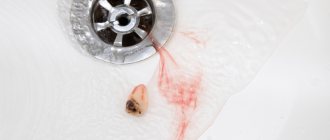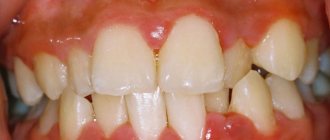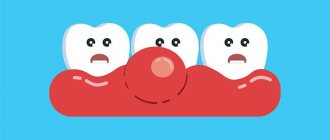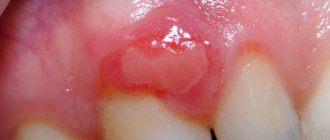Causes of sores in the mouth
Purulent ulcers in the mouth can appear for various reasons. They are often the result of dental diseases.
The list of reasons may include the following:
- viral infections (herpes simplex or herpes zoster);
- fungal and bacterial infections;
- irritation of the mucous membranes from smoking and certain foods (nuts, cheese, citrus fruits);
- ulcerative stomatitis;
- chemotherapy drugs;
- frequent stress and nervous tension;
- oral injuries;
- hormonal changes.
Treatment options
The mucous membrane is very sensitive, so smearing wounds on the gums with iodine and brilliant green is strictly prohibited to avoid getting burned.
Medicines
To treat wounds in the oral cavity, special ointments are used that have an antiseptic effect: Solcoseryl, Metrogyl Denta, Apident. These drugs contain components that eliminate pathogenic microflora.
If a scratch causes pain, special ointments are used to relieve pain and strengthen the gums.
In addition to gels, it is recommended to rinse with the following solutions:
- Chlorhexidine - to clean the wound and protect against germs.
- Miramistin - to prevent infection with fungi leading to stomatitis.
- Hexoral, which contains levomenthol and hexetidine, which have an antiseptic effect.
- Hydrogen peroxide, which cleanses the scratch from dirt and stops the spread of inflammation.
If a white scratch is discovered, indicating suppuration, you cannot do without the help of a dentist, since you will have to open the wound. The doctor will remove any accumulated fluid and treat the cut with antibiotics. If a child has damaged the gums, one of the following antiseptics intended for children will help:
- Cholisal - for children after one year, promotes rapid restoration of damaged tissues, relieves pain.
- Kamistad is an ointment consisting of natural chamomile oil, intended for healing scratches.
- Dentinox-N is used not only for teething, but also for suppuration, redness and burning of the gums.
- Kalgel is an antibiotic that cleanses the wound and stops suppuration.
- Glycerol - used to moisturize and soften the damaged area, as well as to prevent the appearance of scars.
It is recommended that every mother have these medications in her medicine cabinet in order to promptly lubricate the scratch and protect the child from infection. Any of these drugs are lubricated on the gums 2-3 times a day. In this case, it is necessary to observe how the baby tolerates the effect of the medicine, whether there is an allergic reaction.
ethnoscience
Having scratched the gum, you need to immediately begin treatment to prevent inflammation. To do this, you can use folk remedies based on medicinal herbs.
You can quickly and easily get rid of redness and burning using the following formulations:
- 1 tsp tincture of calendula diluted in 200 ml of water - used to rinse wounds, and also used as a compress;
- propolis lozenges for application to the inflamed area of the gum;
- decoction of chamomile and sage, for the preparation of which 1 tsp. dry herbs pour a glass of warm water. This natural antiseptic helps get rid of purulent contents.
In order for the treatment to give the fastest possible effect, you should limit the intake of solid foods, exclude hot seasonings and sour pickled foods from the diet.
By choosing the right oral hygiene products, you can reduce the risk of scratches on your gums. Quitting smoking and strengthening the immune system will help the body fight off any infection. In summer, it is advisable to include more vegetables and fruits in your diet, and take more walks in the fresh air. In winter, it is recommended to drink a vitamin complex to increase immunity.
How can you get rid of sores in your mouth?
How to treat wounds in the mouth if they appear and cause discomfort. Initially, you need to determine the true causes of their occurrence. This will help not only choose the right treatment, but also reduce the risk of relapse. If simply stomatitis has formed, it is not difficult to recognize it, but a purulent wound in the mouth of unknown pathogenesis is a reason to consult a doctor. Particular attention should be paid to lesions that do not heal for more than 10 days.
For a quick recovery, use:
- medicinal ointments with anti-inflammatory effect;
- antibiotics if the cause is a bacterial infection;
- complex of vitamins;
- rinsing with oral antiseptics;
- protective applications;
- painkiller injections;
- laser cauterization.
Causes of scratches on the gums
Gums play a big role in the development and condition of the dentition. Gum tissue, surrounding the surface of the teeth, protects them from infection. Therefore, any damage to the mucous membrane of the gums can lead to destructive processes in the periosteum and infect the periodontium.
Very often, the causes of scratches on the gums are quite banal; they appear due to carelessness:
- When using a hard toothbrush, damage to the mucous membrane occurs, leading to microtrauma.
- The habit of chewing and gnawing foreign objects (pens, pencils, matches, toothpicks). Careless movement can injure your gums.
- Eating solid foods (lollipops, grilled candies, crackers, seeds).
- Damage to the gums by a medical instrument during treatment, tooth extraction, or when installing a prosthesis.
You can scratch your gums with the edges of teeth that are broken or poorly polished. Poor-quality dentures also injure your gums.
However, children are much more likely to injure their gums. Many babies often have the habit of sucking their fingers, pulling toys into their mouths, while damaging the mucous membrane with a nail or a sharp edge. As a result, a painful wound remains on the gum.
A child can get a scratch if:
- eruption of the first tooth, the sharp edge of which can injure delicate tissue;
- accidental bite with the primary incisors located in the front;
- independent attempts to eat with a spoon or fork;
- unexpected falls during the game.
Typically, a scratch on the gum does not cause much discomfort and heals quite quickly. But if pathogenic bacteria get into the wound, the cut can become inflamed and lead to complications that will require long-term treatment.
Complications after a cut on the gum
Deep cut on the gum photo
Sometimes after an injury, a person may notice pain at the site of the scratch. The gums become very swollen, small bumps appear, making it difficult to chew, and aching discomfort and burning occurs. A mark forms near the base of the tooth, which is surrounded by inflamed tissue. Redness and increase in volume are noticeable to the naked eye. You should immediately contact your dentist if you experience the following symptoms of exacerbation and inflammation:
- The scratch becomes white and rises above the surface of the gum.
- Cloudy contents or ichor ooze from the wound.
- The pain becomes tugging or throbbing and spreads to other areas of the jaw.
Most likely, a pathogenic infection or harmful microorganisms got into the cut on the gum, and a purulent inflammatory process began. This point cannot be left unattended: infected exudate can penetrate the root of the tooth, disrupt blood circulation in the periodontium and lead to the formation of acute gingivitis, pulpitis or other complications.
In addition, the person has constant pain, which prevents him from sleeping normally, preventing him from eating and smiling. A characteristic sign of inflammation is an acute reaction to certain foods: pepper, salt, spices or vinegar. The wound begins to itch more, pull and burn, practically does not heal and continues to increase in size. It can cause stomatitis and rashes in the mouth.
Causes
The most common factors that lead to bleeding gums are:
- Improper oral hygiene:
using a brush with hard bristles, strong pressure when brushing, inaccurate use of dental floss, picking with toothpicks and other objects, improper installation of dentures. Due to frequent trauma, gum pockets form, which provoke inflammation.
- Tartar.
With irregular and improper brushing of teeth, plaque forms, which gradually hardens. The stone moves the gum away from the tooth, the tissue becomes inflamed and begins to bleed.
- Dental procedures.
Bleeding may occur after professional cleaning, tooth extraction, or the installation of a filling or implant. A poorly manufactured or fitted structure constantly injures the edge of the gum. In addition, filling material and dentures can cause an allergic reaction.
- Diseases of gums and teeth:
gingivitis, periodontitis, periodontal disease. Inflammatory processes are accompanied by swelling, swelling, exposure of the neck, abrasion and loosening of teeth.
- Infections and viruses.
Herpes, fungus, tonsillitis, influenza, ARVI, tuberculosis, HIV lead to the destruction of the periodontal structure and provoke inflammatory processes in the oral cavity.
- Hypovitaminosis.
Bleeding from the gums occurs when there is a deficiency of vitamins B, K, C, E. A monotonous and unbalanced diet, frequent diets, and inducing vomiting lead to pathology. With a lack of vitamin C, scurvy can develop. During the disease, teeth become loose and begin to fall out.
- Hormonal disbalance.
The problem is observed during pregnancy and puberty, with diabetes. Due to an imbalance of biologically active substances, tissues swell and become looser. In this case, bleeding from the gums occurs not only when brushing teeth and eating solid food, but also from the slightest touch.
- Taking a number of medications.
Blood thinners, including Aspirin, Heparin, and Warfarin, can lead to the problem. Some nonsteroidal anti-inflammatory drugs have similar side effects.
- Blood diseases.
Bleeding disorders often lead to gum pathology: hemophilia, thrombocytopenia. The condition of the mucous membranes also worsens with tumor processes - leukemia and leukemia.
Gum injury!
It is actually very easy to damage your gums. What exactly can cause injury?
- Toothbrush
- dental floss
- toothpick
- irrigator
- interdental brush
- hot drinks
- dental instruments
- chemical solutions
Horizontal movements with a toothbrush and strong pressure with a brush cause partial or complete disruption of the integrity of the gums, this in turn causes the development of caries and causes an increase in the visible size of the tooth.
What needs to be done to prevent this condition:
- Use a medium-hard or soft toothbrush
- If your doctor does not recommend purchasing an electric toothbrush, then use a manual one.
- Do not rub the brush against the teeth forcefully or horizontally, make sweeping movements from the gum to the edge of the tooth and touch the tooth lightly
If the gum is not completely damaged, then it will be capable of self-healing if the person stops injuring his gum.
What to do if the integrity of the gums is compromised:
- Eliminate trauma factor
- Do not clean the damaged area for up to 7 days
- Treat this area with an antiseptic solution up to 3 times a day, 5-7 days
- Make an appointment with your dentist as soon as possible.
Of course, when food gets stuck between your teeth, there is nothing else to clean it out except with dental floss. However, if the dental floss is inserted too deep into the gum, the tissue may tear and uncontrolled resorption of the bone and gum will begin.










